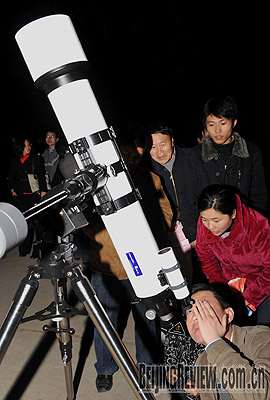|
Lin Huang's obsession with astronomy started 25 years ago when he was a young boy. After being dragged by his father to watch Bertolt Brecht's play, Life of Galileo, Lin became captivated by the heavens and shortly after this awakening, he received a pair of binoculars from his mother as a birthday gift.
 |
|
WATCH THE SKY: Citizens are invited to use the 14 telescopes of the astronomy department at Nanjing University to observe the night sky on the school campus in Nanjing, Jiangsu Province, on April 5 (CHEN QI) | "A new world will appear in front of your eyes once you use a telescope. Since many things are hard to describe in words, you just have to have a look for yourself," Lin said.
Galileo Galilei, Lin's muse and perhaps the most well-known astronomer of all time, used a telescope to observe the skies and enormously broadened humanity's horizons. In commemoration of his achievements, the UN this year will hold the International Year of Astronomy 2009 on the 400th anniversary of the first use of an astronomical telescope by Galileo.
"This first-ever International Year of Astronomy will definitely help bring ordinary people closer to the study of astronomy and the universe," said Lin.
The celebration's theme to encourage people to discover the universe has inspired Chinese astronomy fans like Lin to form teams. His will put their telescopes on streets to encourage passersby to view the stars. The UN program has been promoted in more than 100 Chinese colleges and universities. Looking to stir interest in passersby, Lin tells them, "You can see the moon almost every day, but it looks so different through a telescope. Many people have never even seen the moon's crater-ring mountains."
Organizers slated a project from April 2-5 called the "100 Hours of Astronomy," whose goal is to inspire the public's interest in star-gazing. As part of this, the world's great observatories banded together to offer a live 24-hour webcast called "Around the World in 80 Telescopes." The webcast followed night and day around the globe through the observatories' powerful instruments. The world-class Shanghai Astronomical Observatory was featured in the project's only stop in China.
"Besides actively participating in global and regional activities, China will particularly focus on astronomical education to primary and middle school students and encourage professional and amateur astronomers to offer their knowledge to the public," said Zhu Jin, Director of the Beijing Planetarium. He said the Chinese Astronomical Society and other organizations have planned new training programs for teachers and events geared to popularize the science among children. The society is also preparing for the annual national "star party" for Chinese amateur astronomers.
Stars show off this year
The universe has been cooperative with the International Year of Astronomy, offering plenty and diverse observable phenomena during the course of the year. Many of the natural events can be clearly observed using small amateur binoculars. The Leonid meteor shower is expected on November 18 and meteors are expected to fall at the spectacular rate of more than 500 per hour.
A total solar eclipse, notable for its duration, will occur on July 22. The total eclipse will last for up to six minutes and 39 seconds, compared to the average two-minute solar eclipses to which most are accustomed. It will be the longest total solar eclipse visible from China in the last 2,132 years.
A lunar eclipse usually covers only 1 percent of the Earth's surface and becomes visible in the same place only once every 300 years. During the last several decades, total solar eclipses have only been visible in China in remote and scarcely-populated areas. But the July lunar eclipse will be partially visible in most parts of the country, while a narrow corridor through the heavily-populated middle and upper reaches of the Yangtze River will witness the full eclipse.
| 